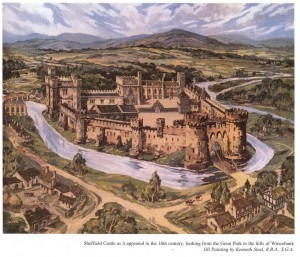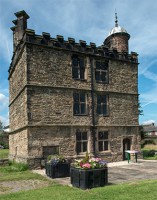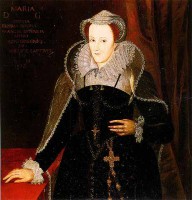I am sure many of our readers ,being born and bred Sheffield and Yorkshire men, are well acquainted with the history of Sheffield, but as I hail from the illustrious county of Lancashire, I will do my best to “take coals to Newcastle” and inform you of your local history!
Sheffield Castle: In its heyday Sheffield Castle was the 4th largest castle in England. Excavations have revealed that an Anglo-Saxon long house was first built on the site followed by a Motte and Bailey castle constructed shortly after the Norman Conquest in 1066 and was attributed to William de Lovetot. This was burnt down in 1266 during the Barons’ Uprising, and a stone castle built in 1270.

The most famous name associated with the castle was Mary Queen of Scots, (poor soul had a rough time of it , not much fun spending 14 years there !!) She was there from 1570 to 1584 and called it the “most hated prison she had been in “, as it was built in an area which was frequently flooded and all the sewage and stench from the rivers of Sheaf and Don accumulated outside the castle walls. (Obviously the builders of the castle didn’t have the benefit of watching Kevin McCloud’s Grand Designs).
The castle covered four acres in area, being larger than Warwick Castle. Maud de Lovetot, granddaughter of William, married Gerard de Furnival in 1204 and the castle and town passed to the Furnival family and royalists. In 1266 anti-monarchy barons captured and burnt down the castle. In 1270 Thomas de Furnival, grandson of Gerard, built a new stone castle which extended from the River Sheaf to Waingate and from the Don to Dixon Lane. A park was attached to the castle which extended to Gleadless in the south and Handsworth in the east. In 1516 George Talbot built an alternative residence in the park called Sheffield Manor.
Destruction of the Castle. In October 1642, during the English Civil War, the town and castle were seized by John Gell for the Parliamentarians. Things, however, changed in 1643 when 8000 Royalists took Rotherham and ransacked the town. The Parliamentarian defenders of the castle fled and the Royalists took control leaving the castle under the control of William Saville with his wife Margaret. In 1644 the castle came under the control of Thomas Beaumont when 1200 Parliamentarians, led by Major General Crawford, were sent to recapture the castle. The castle put up huge resistance but eventually it fell because of the extra-large cannons, brought in specially, which were able to breach the castle walls. Lady Margaret Saville, though pregnant, fiercely defended the castle and gave birth the night the castle surrendered. The castle was badly damaged by the siege and in 1647 the House of Commons passed a resolution for the castle to be demolished. The Earl of Arundel repurchased it with the intention of restoring it but the damage was too great and the castle was razed to the ground before being built over. Archaeological excavations in 1927, by Leslie Armstrong, uncovered the base of the bastion towers and part of the gateway. In 2014 the Heritage Lottery Fund was approached with a view to rebuilding the towers and drawbridge creating a heritage park at the cost of five million pounds but unfortunately the bid was not approved.
Sheffield Park : This was created next to the castle and was bigger than Richmond Park and accommodated three thousand head of deer. There was an avenue of walnut trees and wooded areas known as Holly Haggs for the deer to shelter in. The deer were enclosed by stone walls, topped with cleft oak fencing. Wild deer were captured in the park by “park and pale” – this was a device where the deer jumped over a low wall beyond which was a large ditch. Once on the other side the deer couldn’t escape due to the height of the wall. The noblemen hunted deer outside the Park with ferocious dogs, known as Talbot Hounds, chasing them until they dropped with exhaustion and then the hunter would put the deer out of its misery by running it through with his sword and cut off its head for a trophy. The deer in the Park, on the other hand were kept for venison and when required servants would catch them by using nets and then despatch them with an arrow.
Manor Lodge: In 1516 George Talbot built Manor Lodge as a hunting lodge in SheffieldPark.

It was richly decorated and complete with a banqueting room which is still as it was when Mary Queen of Scots was

imprisoned there. Much of the buildings including the long gallery have been demolished. Bess of Hardwick remodelled the Manor House and a gatehouse, built of brick with twin octagonal towers, was the most impressive of these developments. In 1709 many of the remaining buildings were demolished and the building materials carted away and sold to locals. The complex was converted to barns, farm buildings and a coal mine excavated. By the 1800’s there was little to remind people of the former grandeur of Manor Lodge. Local farmers, cutlers and coal miners transformed it into a self-contained hamlet with shops, a chapel and a beer house (Norfolk Arms). By the 1890’s the cottages were in ruins and the colliery closed and in 1900 all the post-16C buildings were demolished and the site cleared.
Mr. Templeton was very disappointed that the Heritage Bid put in by the Sheffield City Council for funding for the castle had failed. He said that many artefacts found previously had been in storage and not available for public viewing. It was an interesting and informative presentation and it was enjoyed and appreciated by all.
